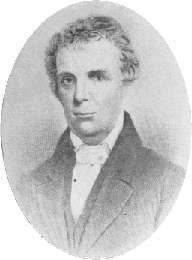Christian Messenger
The Christian Messenger was a religious magazine established by the early Restoration Movement leader Barton W. Stone in 1826.[1][2] The paper was a key means of communication for the "Christians" led by Stone and a primary source of unity in the movement, but consistently struggled for survival.[1] It also played a key role in promoting the merger of the "Christians" with the "Disciples" led by Thomas and Alexander Campbell.[1]
| Editor | Barton W. Stone |
|---|---|
| Categories | Restoration Movement |
| Frequency | Monthly[1] |
| First issue | November 1826 |
| Final issue | April 1845 |
| Country | United States |
| Based in | Georgetown, Kentucky (vols. 1-8); Jacksonville, Illinois (vols. 9-14)[1] |
| Language | English |
History

From the beginning of the movement, the free exchange of ideas among the people was fostered by the journals published by its leaders. Alexander Campbell published the Christian Baptist and the Millennial Harbinger while Stone published the Christian Messenger.[3]:208 The first issue was printed in November 1826, and early themes included opposition to sectarianism, Christian liberty, and the right of individual Christians to read and interpret the Bible for themselves independently of any creeds.[1] Stone also stressed the need for Christian unity based on the New Testament alone.[1] The cornerstone for the Stone movement was Christian freedom, which led them to a rejection of all the historical creeds, traditions and theological systems that had developed over time and a focus on a primitive Christianity based on the Bible.[4]:104,105
During the period from 1831 through 1834 the Messenger actively promoted the union with the Disciples of Christ (Campbell Movement).[1] Stone also used the Messenger to encourage Christians to free their slaves and support the American Colonization Society.[1][5]:717–718
The Messenger had several co-editors over the time it was published, including John T. Johnson, Jacob Creath Jr., T. M. Allen and D. P. Henderson.[1] After Stone died Henderson continued the paper for a few months, after which it was merged with The Bible Advocate in 1847.[1]
References
- Douglas Allen Foster and Anthony L. Dunnavant, The Encyclopedia of the Stone-Campbell Movement: Christian Church (Disciples of Christ), Christian Churches/Churches of Christ, Churches of Christ, Wm. B. Eerdmans Publishing, 2004, ISBN 0-8028-3898-7, ISBN 978-0-8028-3898-8, 854 pages, entry on Christian Messenger, pp. 194-195
- Douglas Allen Foster and Anthony L. Dunnavant, The Encyclopedia of the Stone-Campbell Movement: Christian Church (Disciples of Christ), Christian Churches/Churches of Christ, Churches of Christ, Wm. B. Eerdmans Publishing, 2004, ISBN 0-8028-3898-7, ISBN 978-0-8028-3898-8, 854 pages, entry on Journalism, pp. 435–438
- Garrison, Winfred Earnest and DeGroot, Alfred T. (1948). The Disciples of Christ, A History, St Louis, Missouri: The Bethany Press
- C. Leonard Allen and Richard T. Hughes, Discovering Our Roots: The Ancestry of the Churches of Christ, Abilene Christian University Press, 1988, ISBN 0-89112-006-8
- Douglas Allen Foster and Anthony L. Dunnavant, The Encyclopedia of the Stone-Campbell Movement: Christian Church (Disciples of Christ), Christian Churches/Churches of Christ, Churches of Christ, Wm. B. Eerdmans Publishing, 2004, ISBN 0-8028-3898-7, ISBN 978-0-8028-3898-8, 854 pages, entry on Stone, Barton Warren, pp. 700–720